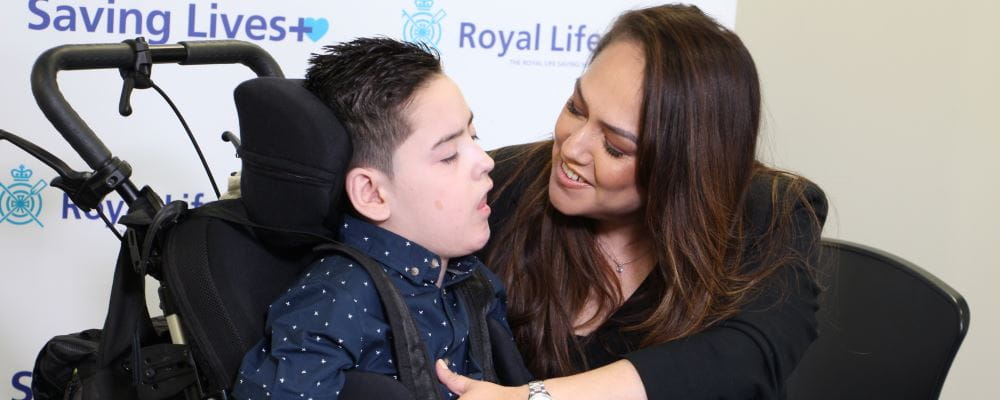
Non-fatal drowning survivor Ari Morrison with his mum Simone Soto Flores
Parents urged to Keep Watch after 965 toddler drownings death in 25 years
A new report Royal Life Saving Society report reveals that 965 children aged 0-4 years drowned in Australia between 1 July 1993 and 30 June 2018. Western Australia recorded the third highest drowning rate of any state or territory.
Data shows that over the past 10 years 34 children aged 0-4 years have drowned in Western Australia with 74% of these drowning deaths occurring in the metro Perth area and 26% in regional WA. With summer just around the corner Royal Life Saving is launching the Keep Watch campaign, urging parents and carers to supervise children around water at all times.
Royal Life Saving WA Senior Manager Health Promotion and Research, Lauren Nimmo, says a lapse in adult supervision was the major risk factor in 100% of toddler drowning deaths. “It only takes a few moments for a child to slip away unnoticed, fall into the water and drown. Drowning is often quick and silent. Distractions like performing household tasks, attending to another child, or ducking inside to grab something can have tragic consequences if a toddler is left unattended by water.”
Home swimming pools are the leading location for drowning deaths among young children in Australia, accounting for more than half of the drowning deaths occurring in this age group. Faulty or propped open gates are the primary risk factors in home pool drowning deaths involving young children.
Ms Nimmo said preventing accidental drowning requires multiple layers of protection. “Active supervision is the best protection against child drowning, however kids can be quick and hard to keep up with so it’s vital to fence pools and spas to prevent children gaining access. We urge all home pool owners to regularly check that your fence and gate are in working order, and never prop the gate open.”
In the past ten years 874 drowning incidents involving young children have been recorded in Western Australia, with 389 children admitted to hospital as a result and 451 emergency department presentations in the Perth metro area. Many children who’ve suffered a non-fatal drowning live with a permanent disability as a result.
Simone Soto-Flores’ son Ari drowned in June 2012, after falling from a houseboat while on holiday in the United States with his father, step-mum and siblings. Ari had woken from a nap and fallen overboard unnoticed. Within minutes he was found lifeless in the water and underwent extensive hospital treatment. Although he was brought back to life he suffered severe brain damage due to lack of oxygen. Simone says in that moment their life changed forever.
“Many of the stories we hear are either about fatal drowning deaths or children who have emerged unscathed from a drowning incident. The majority of people don’t know what happens when a child survives a drowning but is left with severe brain damage. The reality is that Ari is a severely disabled little boy. He’ll require life-long care and therapy sessions, medical appointments, x-rays and special equipment are a constant feature in his life. We still don’t know what the future holds. All we can do is focus on the positives and make sure Ari leads a full life.”
Simone in now a Keep Watch Drowning Prevention Ambassador, urging all parents to be very aware of the need to closely supervise their children around water at all times. “Toddler drowning is preventable, but awareness is the only way forward for preventing other families from going through a tragedy like this. There are things we can all do to stop drowning happening. When your children are around water, never take your eyes away, not even for a second. All parents need to learn CPR, it can save a life!”
Lauren Nimmo says it’s pleasing that the drowning rate has significantly decreased across Australia in recent years, thanks largely to action at a government and community level. “Drowning prevention bodies have made a concerted effort in areas such as government policy and enforcement, public awareness and education programs such as Keep Watch, advocacy and research. The introduction and subsequent strengthening of pool fencing legislation, including the introduction of swimming pool registers and inspection regimes, has contributed to making the home pool environment safer for young children, saving an estimated 550 lives over the past 20 years” said Ms Nimmo.
“If the rate of drowning we had twenty years ago continued today, 70 children aged 0-4 would have drowned in Australia last year, in reality 18 young lives were lost. While this is substantial progress, and many lives have been saved, we won’t stop campaigning until it is zero.”
Although there has been a significant reduction in the rate of drowning among toddlers, drowning remains one of the leading causes of accidental death of children aged 0 - 4 years old.
Royal Life Saving recommends the following Keep Watch safety tips to keep your child safe from drowning:
- Supervise – always Keep Watch of your child in and around water
- Prevent your child’s access to water at all times
- Learn – teach your child to be water confident
- Respond – learn CPR and call 000 in an emergency
For further tips on toddler drowning prevention please click the link below.

Simone and Ari's full story is available at this link.
